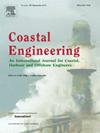Numerical modeling and observations of infragravity wave propagation and amplification within a small, confined harbor
IF 4.5
2区 工程技术
Q1 ENGINEERING, CIVIL
引用次数: 0
Abstract
Infragravity (IG) waves are long-period oscillations capable of propagating into and resonating within harbors, and pose significant risks to maritime operations. High-resolution water level observations suggest the dominant IG wave energy source within in a small harbor originate offshore, propagating as free waves that undergo amplification due to the harbor’s geometric configuration, resulting in significant harbor seiching. Strong correlations are observed between offshore wave parameters and IG wave energy, with significant wave height and average wave period being the primary drivers. Additionally, directional wave spreading plays a critical role in the generation and propagation of IG waves. A numerical modeling framework, using SWAN to resolve the nearshore wave climatology and FUNWAVE-TVD to investigate harbor resonance, successfully models IG wave amplification events and enables the identification of the eigenmodes and nodal patterns within the harbor. However, the coupled modeling methodology under-predicts the propagation of short-period wind waves into the harbor which nominally contribute to wave agitation. Results highlight the crucial influence of wave directionality, directional spread, and spectral shape on IG wave amplification in confined coastal environments. These findings enhance our understanding of IG wave dynamics and have important implications for harbor design, coastal resilience, and maritime safety.
小型密闭港湾内亚重力波传播与放大的数值模拟与观测
亚重力波是一种长周期振荡,能够传播到港口并在港口内产生共振,对海上作业构成重大风险。高分辨率的水位观测表明,在一个小港口内,主要的IG波能量源起源于近海,作为自由波传播,由于港口的几何结构而被放大,导致严重的港口堵塞。近海波参数与IG波能量有较强的相关性,其中波高和平均波周期是主要驱动因素。此外,定向波传播在IG波的产生和传播中起着至关重要的作用。利用SWAN解析近岸波气候学和FUNWAVE-TVD研究港口共振的数值模拟框架,成功地模拟了IG波放大事件,并能够识别港口内的特征模态和节点模式。然而,耦合模拟方法对短周期风波在港口内传播的预测不足,而短周期风波在名义上有助于波浪的搅拌。结果强调了波浪的方向性、方向扩散和频谱形状对狭窄海岸环境下IG波放大的重要影响。这些发现增强了我们对IG波浪动力学的理解,并对港口设计、海岸恢复力和海上安全具有重要意义。
本文章由计算机程序翻译,如有差异,请以英文原文为准。
求助全文
约1分钟内获得全文
求助全文
来源期刊

Coastal Engineering
工程技术-工程:大洋
CiteScore
9.20
自引率
13.60%
发文量
0
审稿时长
3.5 months
期刊介绍:
Coastal Engineering is an international medium for coastal engineers and scientists. Combining practical applications with modern technological and scientific approaches, such as mathematical and numerical modelling, laboratory and field observations and experiments, it publishes fundamental studies as well as case studies on the following aspects of coastal, harbour and offshore engineering: waves, currents and sediment transport; coastal, estuarine and offshore morphology; technical and functional design of coastal and harbour structures; morphological and environmental impact of coastal, harbour and offshore structures.
 求助内容:
求助内容: 应助结果提醒方式:
应助结果提醒方式:


